Benefits and Advantages of Sourdough Dinner Rolls
Sourdough dinner rolls bring several appealing benefits that make them a favorite choice for many home cooks and diners. One of the main advantages is the ease of preparation: the natural fermentation process allows the dough to develop complexity with minimal active effort, making it beginner-friendly while delivering artisanal results. Health benefits include the presence of probiotics formed during fermentation, which support digestive health and may improve gut flora balance.
Additionally, sourdough fermentation helps break down gluten proteins, which can make these rolls easier to digest compared to regular bread. The distinctive tangy flavor combined with a soft, chewy crumb sets sourdough rolls apart, offering more flavor depth than typical dinner rolls. This recipe balances taste, nutrition, and simplicity, resulting in fluffy, buttery, and wholesome rolls perfect as a crowd-pleasing side or appetizer.
Jump to:
- Benefits and Advantages of Sourdough Dinner Rolls
- Essential Ingredients for Sourdough Dinner Rolls
- Dietary Substitutions to Customize Your Sourdough Dinner Rolls
- Gluten-Free Adaptation
- Vegan Variations
- Low-Calorie Options
- Allergy Considerations
- How to Prepare the Perfect Sourdough Dinner Rolls: Step-by-Step Guide
- Mastering Sourdough Dinner Rolls: Advanced Tips and Variations
- How to Store Sourdough Dinner Rolls: Best Practices
- Nutritional Value of Sourdough Dinner Rolls
- FAQs: Frequently Asked Questions About Sourdough Dinner Rolls
- Can I double the sourdough dinner rolls recipe without changing the baking time?
- How long should I let sourdough dinner rolls proof before baking?
- Can I use a stand mixer to make sourdough roll dough?
- What are the best storage methods to keep sourdough dinner rolls fresh?
- Can I make sourdough dinner rolls ahead and refrigerate them before baking?
- Simple and Soft Sourdough Dinner Rolls Recipe with Step-by-Step Video Guide
- Ingredients
- Instructions
- Last Step:
- Notes
- Nutrition
- Did you make this recipe?
Essential Ingredients for Sourdough Dinner Rolls
To make soft and flavorful sourdough dinner rolls, gather the following ingredients:
- 500g bread flour (or substitute with all-purpose flour for a softer texture)
- 150g active sourdough starter (fed and bubbly)
- 10g fine sea salt
- 300ml room temperature water
- 25g olive oil or unsalted butter (plus extra butter for brushing)
- 150ml milk at room temperature (can substitute with non-dairy milk such as almond milk)
- 2 to 3 tablespoons granulated sugar (adjustable according to sweetness preference)
These ingredients combine to create a tender crumb with a characteristic tangy flavor. For vegan options, verify the sourdough starter is maintained vegan-friendly. Gluten-free adjustments can be made using gluten-free flour blends, though hydration adjustments will be necessary. Lower-fat versions can reduce or replace oil or butter with alternatives like oil spray.
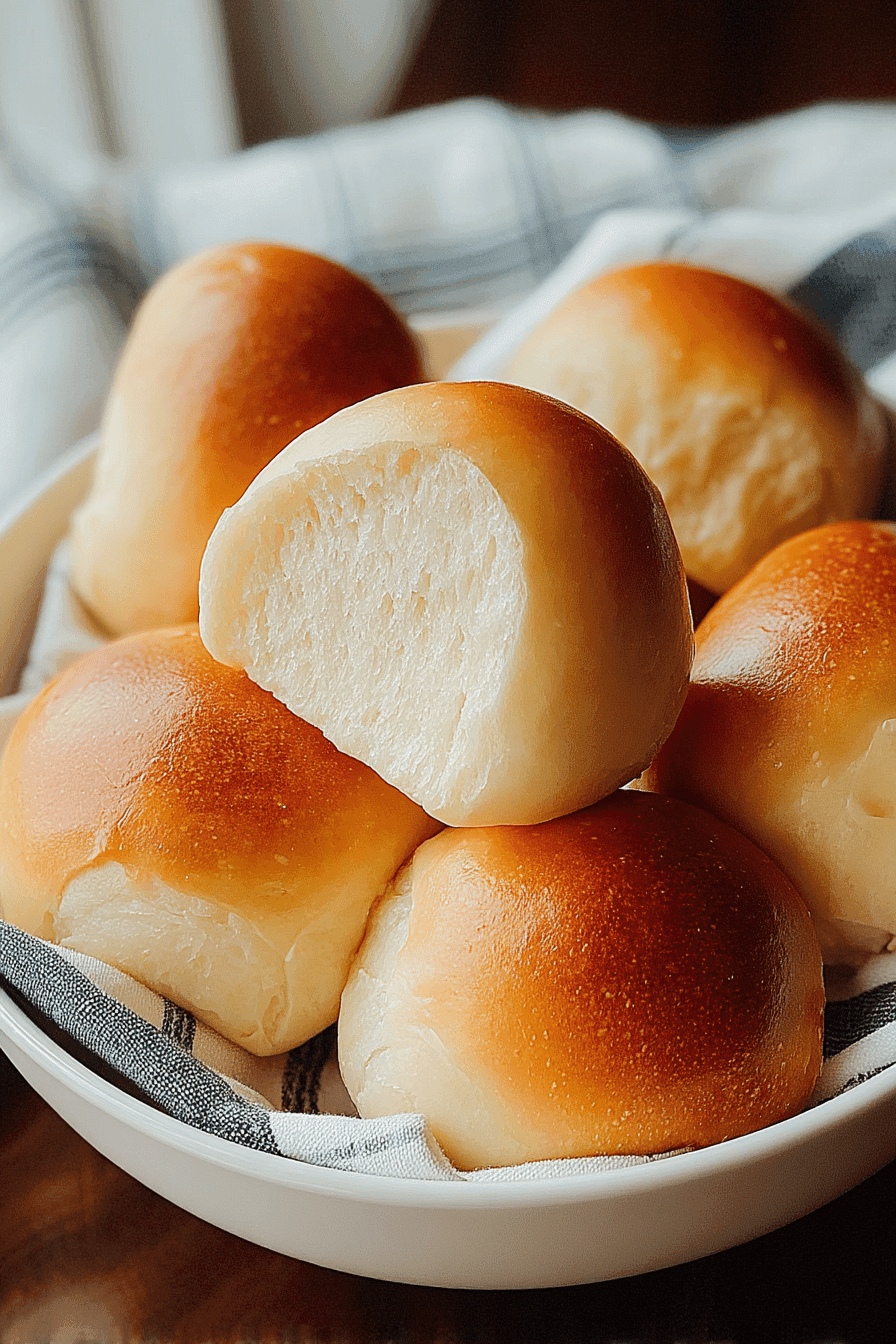

Dietary Substitutions to Customize Your Sourdough Dinner Rolls
Adapting sourdough dinner rolls for specific dietary needs is surprisingly straightforward with suitable substitutions:
Gluten-Free Adaptation
- Replace bread flour with a certified gluten-free flour blend matched for bread baking.
- Add xanthan gum or psyllium husk powder to mimic gluten’s elasticity and help the dough hold its shape.
Vegan Variations
- Ensure the sourdough starter is vegan and avoid any dairy-based ingredients.
- Use plant-based milk substitutes such as almond or oat milk.
- Substitute butter with vegan-friendly margarine or oils.
Low-Calorie Options
- Reduce the amount of oil or substitute with a light cooking spray.
- Reduce or substitute sugar with natural alternatives such as honey or coconut sugar (if suitable) or use less overall.
Allergy Considerations
- Avoid nut-based oils or toppings if allergic.
- Monitor salt levels for low-sodium diets, understanding that salt affects fermentation speed and flavor.
These dietary adaptations help keep the rolls inclusive and delicious without sacrificing their signature sourdough characteristics.
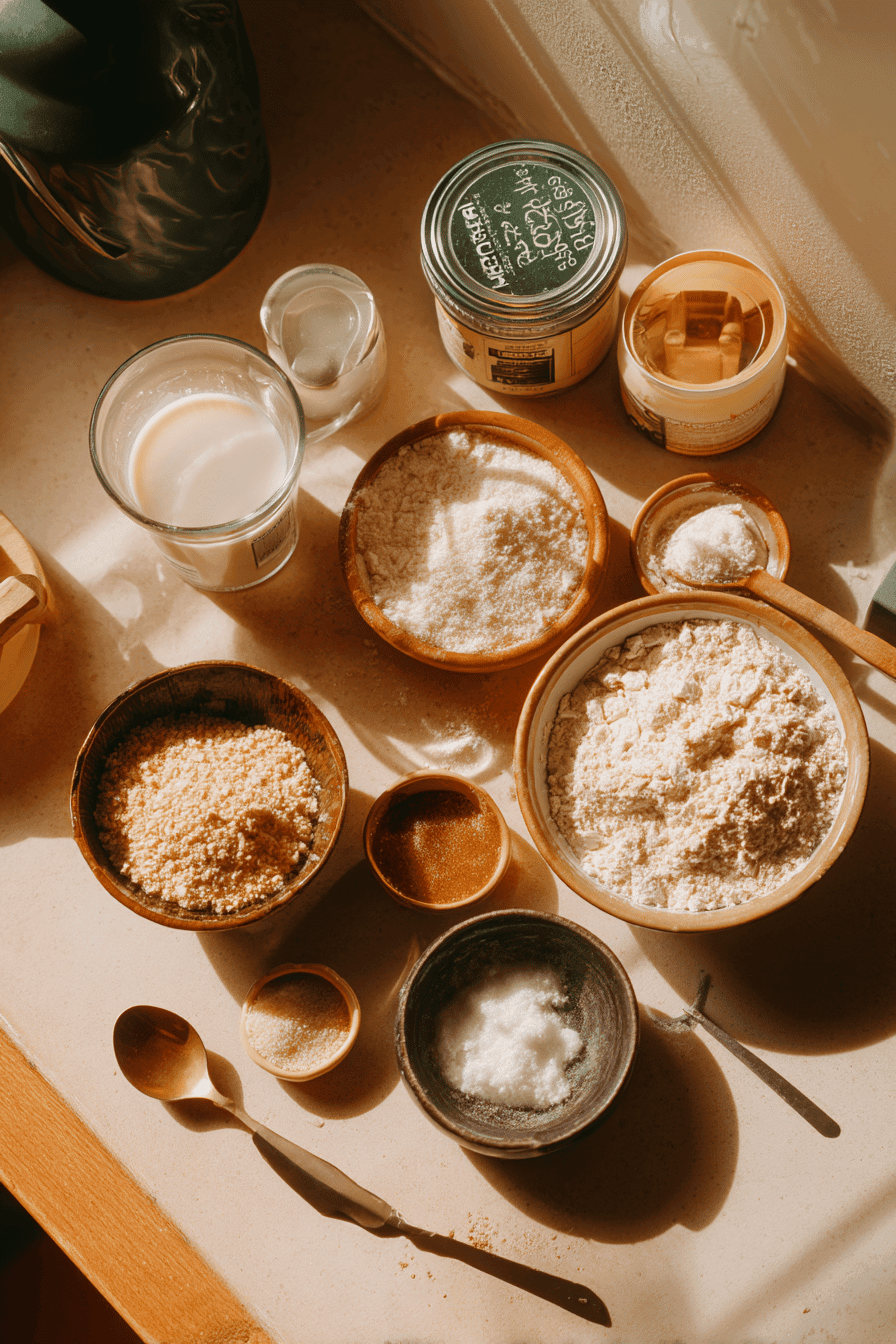
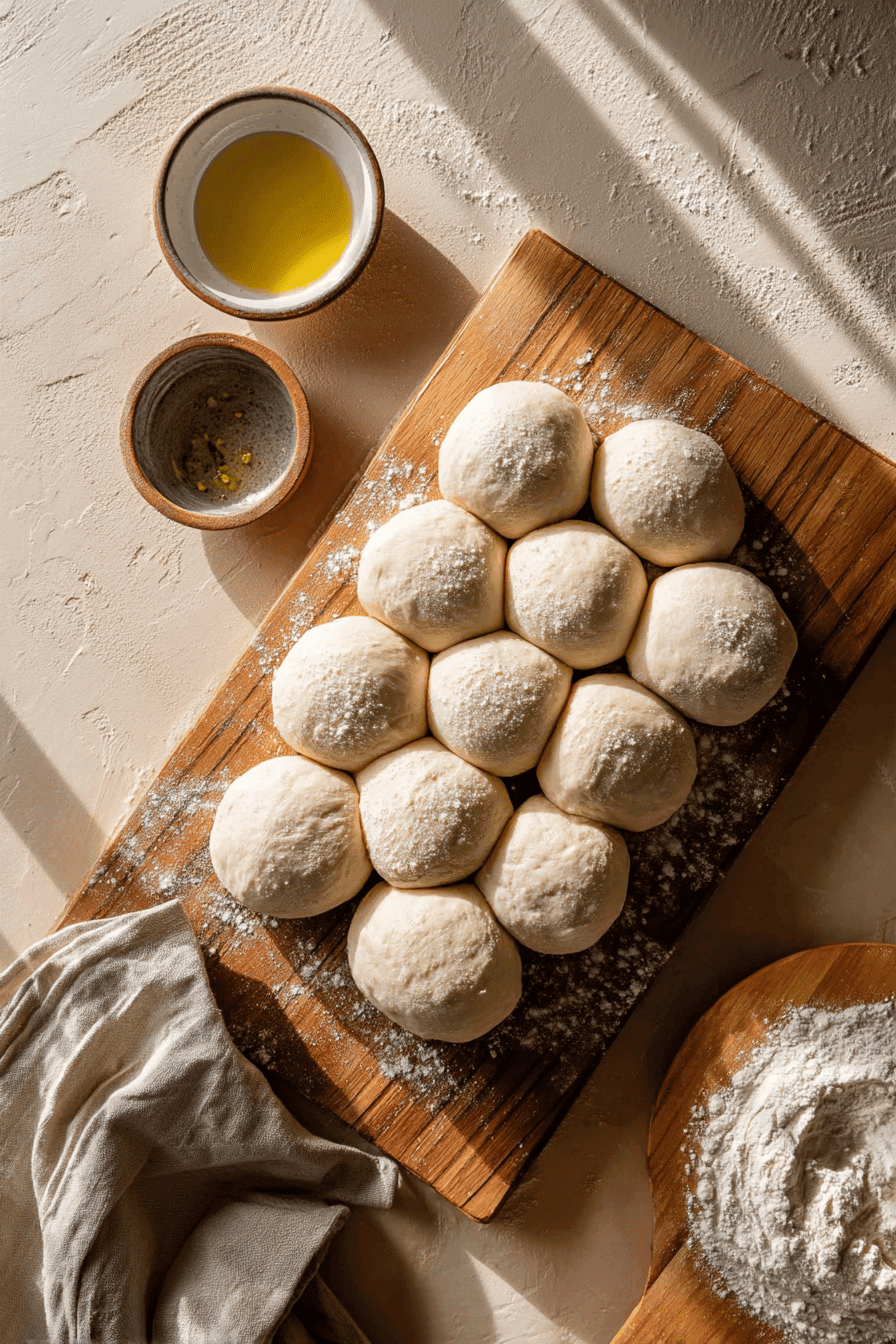
How to Prepare the Perfect Sourdough Dinner Rolls: Step-by-Step Guide
- Prepare the starter: Feed your sourdough starter about 12 hours before mixing until it is bubbly and doubled in size.
- Mix liquids: Melt unsalted butter, then combine it with milk, sugar, and salt over low heat; stir until sugar dissolves. Cool this liquid mixture to room temperature.
- Combine dough: In a large mixing bowl, mix bread flour with active sourdough starter. Gradually add the cooled liquid mixture and water, stirring until just combined. Cover with a damp towel and let rest for 30 minutes (autolyse) to relax the gluten.
- Knead the dough: Knead by hand or with a stand mixer on medium speed for 8-10 minutes until the dough is smooth and elastic.
- Bulk ferment: Place dough in a greased bowl, cover, and let ferment at room temperature for 8 to 12 hours or until it doubles in size. Slow fermentation enhances flavor and texture.
- Divide and shape: Turn dough onto a lightly floured surface and divide into 12 equal pieces (~65g each). Shape each into tight, smooth balls by pinching the sides and rolling the dough, then place seam side down in a greased baking dish.
- Proof: Cover loosely and proof at room temperature for 3-4 hours until the rolls puff and nearly double. Alternatively, refrigerate for 8-24 hours for cold fermentation, removing 3-5 hours before baking for final rise at room temperature.
- Bake: Preheat the oven to 375°F (190°C). Bake the rolls on the upper third rack for 25-30 minutes, until golden brown and hollow sounding when tapped. Adjust baking time if using metal pans or for different oven characteristics.
- Finish: Brush the hot rolls with melted butter for added flavor and shine. Cool on a wire rack before serving.
“Taking time for slow fermentation and careful shaping produces soft, tangy sourdough rolls with the perfect pull-apart texture.”
To deepen your starter care knowledge, see how to make sourdough starter. For additional baking tips on soft rolls, check tips for baking soft dinner rolls.
Mastering Sourdough Dinner Rolls: Advanced Tips and Variations
Mastering sourdough dinner rolls involves understanding your starter’s activity and adapting fermentation conditions. Regularly feeding your sourdough starter keeps it lively, ensuring a strong rise and a pleasant tangy flavor. Experimenting with fermentation times and temperatures can help balance acidity and crumb texture longer cold fermentation deepens flavor while slower room temperature rises improve lift.
Incorporate whole grain flours like whole wheat or rye for added nutrients and a richer, earthier taste. To achieve a soft and shiny crust, brush rolls with melted butter before or after baking. For flavor variations, mix fresh herbs like rosemary or thyme, or add finely minced garlic or shredded cheese to the dough.
Using preferments or an overnight cold proof in the refrigerator not only enhances flavor complexity but also offers flexibility in baking schedules. These techniques help you create sourdough rolls that are flavorful, soft, and perfectly textured every time.
“Patience with fermentation and creativity with flavors unlock the full potential of sourdough dinner rolls.”
How to Store Sourdough Dinner Rolls: Best Practices
To maintain the freshness and texture of sourdough dinner rolls, store them properly depending on how soon you plan to consume them. For short-term storage (up to 2 days), keep rolls in a paper bag or bread box at room temperature. This allows air to circulate, preserving the crust’s slight crispness.
For storage up to a week, wrap rolls tightly in plastic wrap or place them in an airtight container before refrigerating; however, refrigeration may slightly dry the crust. For longer storage, freeze rolls in airtight freezer bags for up to three months.
When reheating frozen rolls, warm them gently in a preheated oven at 160°C (320°F) for 10–15 minutes to restore the crust’s crispness and keep the crumb soft. Avoid microwaving, as this may make rolls tough or chewy.
Proper storage helps maintain the rolls’ signature soft texture and tangy flavor, ready to complement any meal.
Nutritional Value of Sourdough Dinner Rolls
| Nutrient | Amount per Roll (Approx.) | Details |
|---|---|---|
| Calories | 160-165 kcal | Moderate energy content suitable for balanced diets |
| Carbohydrates | 28-29 g | Provides sustained energy from complex starches |
| Protein | 5 g | Assists in muscle repair and maintenance |
| Fat | 3 g | Includes healthy fats from olive oil and butter |
| Fiber | Variable, depending on flour type | Fermentation improves digestibility and nutrient absorption |
| Sodium | Variable | Adjustable in recipe to suit dietary needs |
Sourdough rolls offer a wholesome mix of macronutrients and beneficial fermentation byproducts. Fermentation reduces phytic acid, enhancing mineral absorption including iron and zinc. Selecting whole grain flours increases fiber content. These rolls present a nutritious option rich in flavor and texture.
Learn more about the nutritional benefits of sourdough bread.
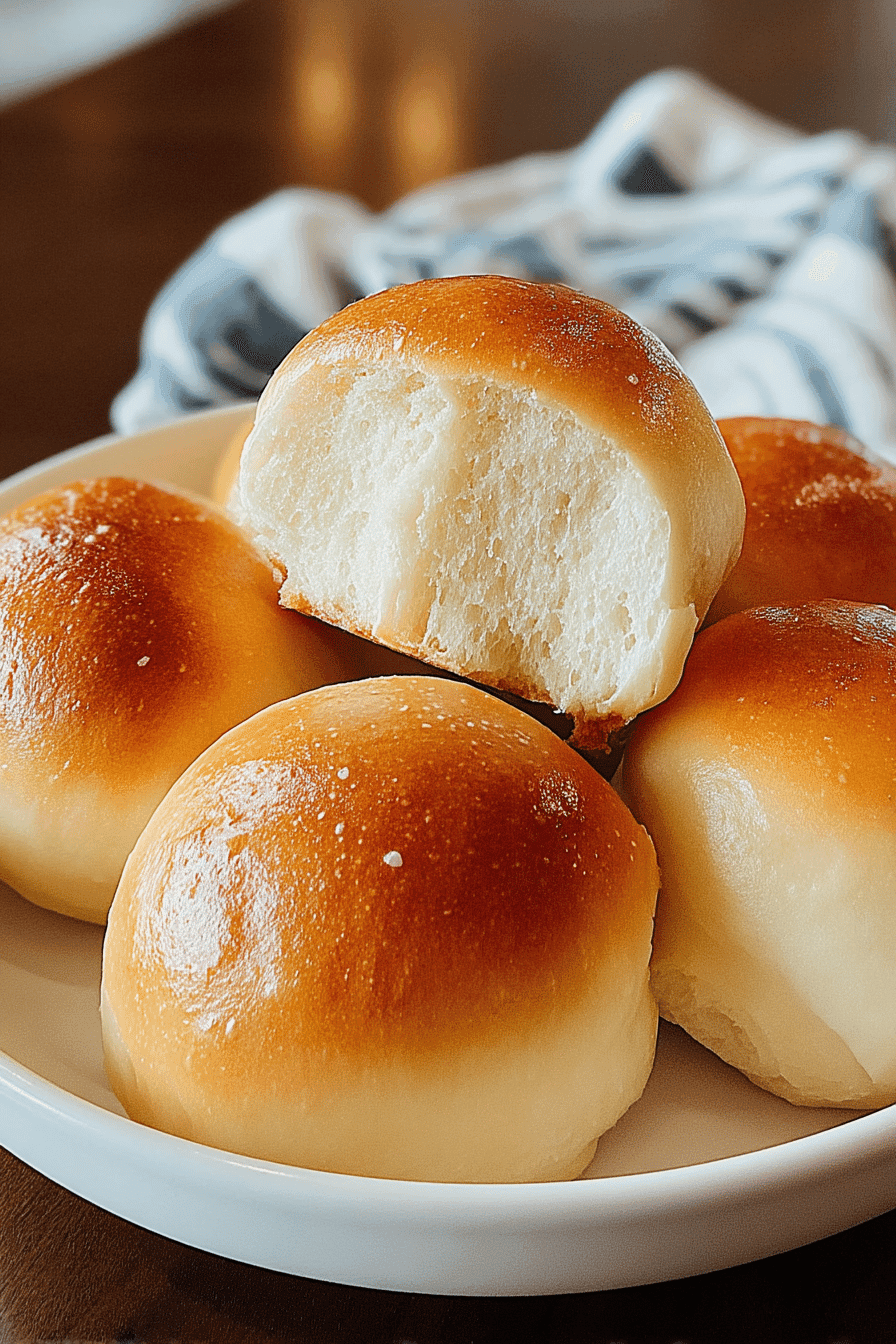

FAQs: Frequently Asked Questions About Sourdough Dinner Rolls
Can I double the sourdough dinner rolls recipe without changing the baking time?
How long should I let sourdough dinner rolls proof before baking?
Can I use a stand mixer to make sourdough roll dough?
What are the best storage methods to keep sourdough dinner rolls fresh?
Can I make sourdough dinner rolls ahead and refrigerate them before baking?
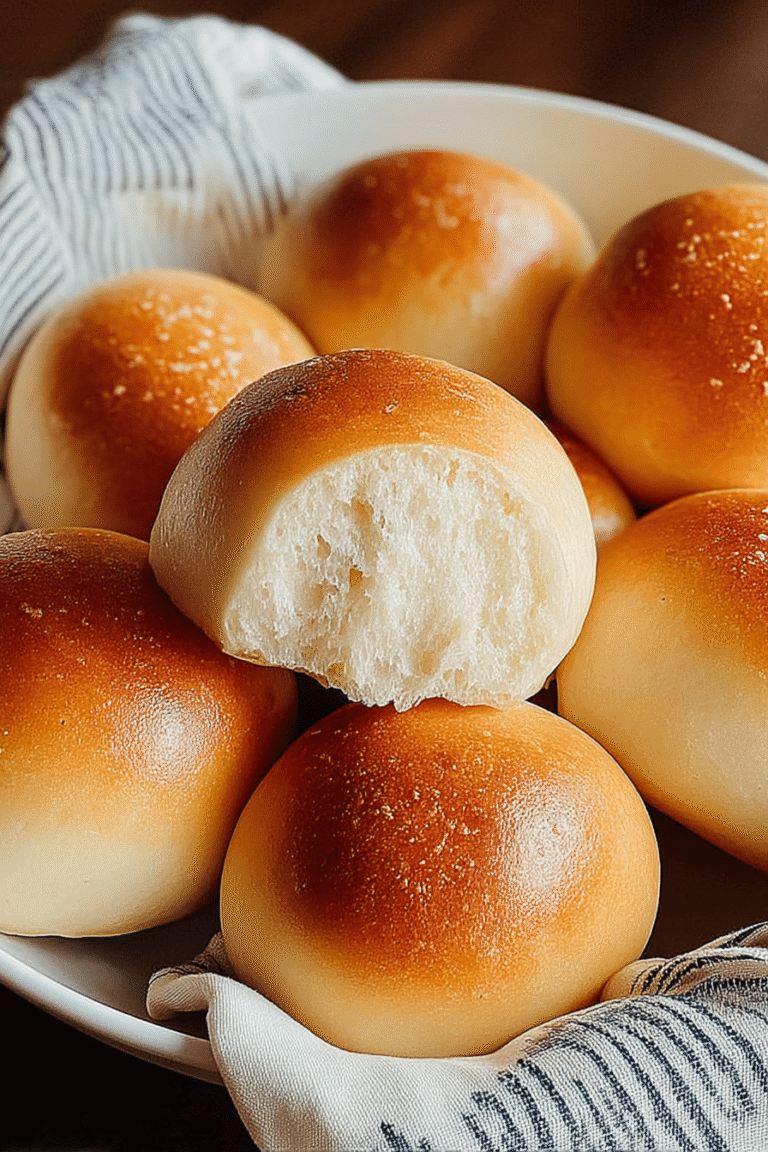
Simple and Soft Sourdough Dinner Rolls Recipe with Step-by-Step Video Guide
🥖 Discover the pleasure of soft, tangy sourdough dinner rolls that perfectly complement any meal with their fluffy texture.
🍞 These homemade rolls offer a delightful pull-apart experience, bringing a gourmet touch to your dinner table!
- Total Time: 13 hours
- Yield: 12 rolls 1x
Ingredients
For active sourdough starter (½ cup):
1 tablespoon starter, ⅓ cup plus 1 tablespoon all-purpose flour, 3½ tablespoons water (fed 12 hours before use until bubbly and doubled)
For the dough:
2 tablespoons unsalted butter (plus more for brushing)
1 cup milk at room temperature (can substitute with non-dairy milk such as almond milk)
2 to 3 tablespoons granulated sugar (adjustable, 1 tablespoon if reducing sweetness or using alternatives like honey or coconut sugar)
1 teaspoon fine sea salt
½ cup active sourdough starter (bubbly and at peak)
3 cups plus 2 tablespoons bread flour, or all-purpose flour as a substitute
1 teaspoon salted butter for brushing after baking (optional)
Instructions
1. Prepare the starter: Feed the sourdough starter about 12 hours before mixing so it becomes bubbly and doubles in size.
2. Mix liquids: Melt the butter, then combine it with milk, sugar, and salt over low heat; stir until sugar dissolves and cool to room temperature.
3. Combine dough: In a mixing bowl, mix the liquid mixture with flour and the active starter until just combined. Cover with a damp towel and rest for 30 minutes to relax the gluten.
4. Knead: Knead the dough by hand for 8-10 minutes or with a stand mixer dough hook on medium speed for 8-10 minutes until smooth and elastic.
5. Bulk ferment: Transfer the dough to a greased bowl, cover with a damp towel, and let ferment at room temperature for 8 to 12 hours, or until doubled in size. This slow fermentation develops flavor and texture.
6. Divide and shape: Turn the dough onto a lightly floured surface and divide into 12 equal pieces (~65 grams each). Shape each piece into a tight, smooth ball by pinching the sides and rolling on a smooth surface, placing each seam side down into a greased glass or ceramic baking dish.
7. Proof: Cover the rolls with a damp towel and let rise for 3-4 hours at room temperature, or until puffy and nearly doubled. Alternatively, cover rolls tightly and refrigerate for 8-24 hours; remove 3-5 hours before baking to proof at room temperature.
8. Bake: Preheat oven to 375°F (190°C). Bake rolls on the upper third rack for 25-30 minutes until golden brown and internal temperature reaches 190°F. Metal pans can be used but may require baking at 400°F for a shorter time.
9. Finish: Brush hot rolls generously with melted butter before serving.
Last Step:
Please leave a rating and comment letting us know how you liked this recipe! This helps our business to thrive and continue providing free, high-quality recipes for you.Notes
🥶 Kitchen temperature affects rise times: warmer kitchens speed up proofing, cooler ones require longer.
🥯 Use bread flour for fluffier rolls with better rise; all-purpose is a good substitute but yields a slightly denser crumb.
🌿 Shaping with tension (rolling tight balls and sealing seams) encourages good oven spring and round shape.
- Prep Time: 40 minutes
- Total Fermentation Time: 12 hours
- Cook Time: 30 minutes
- Category: Bread
- Method: Baking
- Cuisine: French
- Diet: Vegetarian
Nutrition
- Serving Size: 1 roll
- Calories: 162
- Sugar: 3g
- Sodium: 180mg
- Fat: 3g
- Saturated Fat: 2g
- Unsaturated Fat: 1g
- Trans Fat: 0g
- Carbohydrates: 28g
- Fiber: 1g
- Protein: 5g
- Cholesterol: 5mg







